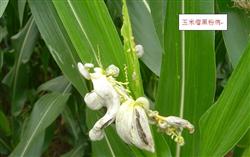Pay attention to the prevention and control of maize tumor smut

The symptoms of the disease can be infected in all parts of the ground during the whole growth period of corn, especially in the male-pumping stage. tumors of different sizes are produced in the affected part. at the initial stage, the tumor is wrapped in a white film, then turns gray, and then spreads black powder after cracking. that is, the spores of the pathogen. It is easy to produce tumor-like heaps of bean grains on the leaves, cystic gall tumors on the male ear, and large tumors in other parts. The pathogen is Yushu smut fungus, which belongs to basidiomycete subphylum fungi. the chlamydospores are oval or globose, thick, tea-brown, with fine prickly protuberances on the surface, with a size of 8 ~ 13 × 3 ~ 13 μ m. After binucleate hyphae are combined in vivo and in vitro, corn can develop rapidly in host tissue, stimulate tumor formation and produce chlamydospores. The transmission route and pathogenic conditions of the disease are as follows: chlamydospores are overwintered by chlamydospores in soil or manure, or with disease remains and seeds in soil. Chlamydospores first produce basidiospores or secondary basidiospores after overwintering, which are transmitted by airflow or Rain Water and insects, invade from the epidermis or wounds of the young tissue of the host, stimulate host cells to expand, form tumors after 2 weeks, and produce chlamydospores in the tumor after 20 weeks. The rupture of the tumor gives off a large amount of black powder, which can be infected many times a year. High temperature, drought or too much nitrogen fertilizer is easy to develop. The optimum temperature for chlamydospore germination was 26 ℃, the highest temperature was 36 ℃, and the lowest temperature was 8 ℃. The optimum temperature for basidiospore germination was 20 ℃, and the highest temperature was 40 ℃. The main control methods are as follows: (1) Sweet corn is susceptible to disease, especially the selection of disease-resistant varieties. (2) the seriously diseased fields should be rotated for 2-3 years. (3) after the disease appeared in the field, it should be removed and buried deeply in time, and ploughed deeply in time to reduce the source of primary infection. (4) seed treatment, using 1000 milliliters of 20% triadimefon EC, mixing 25 kg seeds, or 2% Suboli wettable powder 1 g, mixing 20 kg seeds, or mixing seeds with 0.2% copper sulfate, or soaking seeds with 0.1% antibacterial agent 401 can reduce the damage.
- Prev

Integrated Control of Three Pests on Spring Soybean
1. Ground tiger. The main pest infesting local crops is cutworm. 1, damage characteristics: larvae bite seedlings from the ground, resulting in lack of seedlings broken ridge, main stem lignification, feeding near the ground plant root epidermis, causing root injury, affecting the plant roots to absorb water, so that the plant gradually wilted and died.
- Next

Problems needing attention in the use of herbicides in Maize planting
1. If the base fertilizer is insufficient, topdressing can make up the base fertilizer. The advantage of topdressing and replenishing farm manure is to increase the content of organic matter in soil and enhance the aggregate structure of soil. However, most farmers often ignore this point in maize cultivation and do not pay attention to the application of base fertilizer. The insufficient topdressing of base fertilizer (mainly chemical fertilizer) can only make the soil thinner and thinner.
Related
- The first cup of black tea in spring, the flavor and history of tea gardens in Kenya, Africa
- The computer can not only choose potatoes, but also grow tea rice. AI will grow winter oolong tea champion.
- It is not only the inflated tea bitten by insects, but also engraved with the four seasons tea in Beipu.
- The Oriental Beauty Tea Festival in Zhuxian County takes the stage at the weekend to experience the plus-size feast of oil tea.
- & quot; Oriental Beauty Tea & Exploration of Emei in Hsinchu, the hometown of quot;
- The new variety of strawberry "Tainong 1" dessert is the first choice with mellow aroma. Crimson gorgeous
- History of Tea in Taiwan: from Wild Inner Mountain to Export Tea Garden
- Two types of Taiwan Oriental Beauty Black Tea won the British three-Star Award for Childhood Tea Xiang Zhang Jiaqi changed from pilot to champion tea maker.
- Banana species and varieties: the planting history of Taiwan Xianren banana and dwarf banana is long, is banana disease resistant?
- Coffee planting Technology: Qianjie Coffee from Seedling to harvesting

